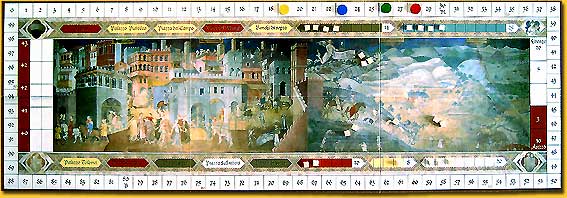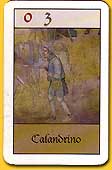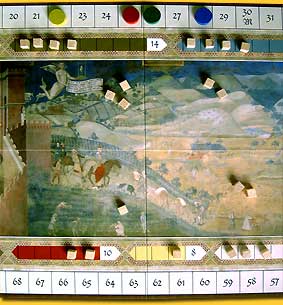Siena
page 2
| x |
|
|
|
|
|
|
|
|
|
|
|
|
|
|
|
|
|
|
|
|
|
|
|
|
|
|
|
|
|
|
|
|
|
|
|
|
|
|
|
|
|
|
|
|
|
|
|
|
|
|
 |
| x |
|
|
|
|
|
|
|
|
|
|
|
|
|
|
|
|
|
|
|
|
|
|
|
|
|
|
|
|
|
|
|
|
|
|
|
|
|
|
|
|
|
|
|
|
|
|
|
|
|
|
|
The banker also has the possibility to contribute to the construction of the tower; every (higher) level brings (more) points at games end.
The game ends when the tower has reached the seventh level, when the 8-point artist card has been auctioned, or when 20 rounds have been played, whichever comes first. Only players that have upgraded to banker count their points, farmers and merchants are excluded from victory.
|
 |
|
|
|
|
|
|
|
|
|
|
|
|
|
|
|
|
|
|
|
|
|
|
|
|
|
|
|
|
|
|
|
|
|
|
|
|
|
|
|
|
|
|
|
|
|
|
|
When playing ‘Siena’ a thorough rules study by áll players is necessary; even to refresh the rules it takes some 20 minutes for the 12 (!) pages A4 rules booklet. And what a lot of small rules there are; it resembles a war game! But what difference does it make that a farmer has to raise his bid by 5, a merchant by 3, and a banker by 1? And from the special cards only the lowest gets auctioned each time - what difference does it make? The poorest player gets new cards for free when refilling his hand, the richest player pays up to 3 extra, unless the card costs 0 - what difference does it make?
What does make a difference however, is that each round the poorest player is the first to take a card, and also decides who starts the round. This can be a nice advantage.
|
|
  |
| x |
|
|
|
|
|
|
|
|
|
|
|
|
|
|
|
|
|
|
|
|
|
|
|
|
|
|
|
|
|
|
|
|
|
|
|
|
|
|
|
|
|
|
|
|
|
|
|
|
|
|
 |
|
Once the game is under way, much of it goes by itself, but the meaning of the special cards still has to be looked up. Because the cards all have a detail of the painting as illustration, it keeps one guessing after its meaning; there is no illustrated summary that helps you out at a glance. These summaries can be downloaded, from BoardGameGeek, or even the Dutch distributor, but it should have been part of the game initially. The rules are very unstructured and not to the point; and the hysteric political correctness finally leads to illegibleness: he/she, his/her... |
| x |
|
|
|
|
|
|
|
|
|
|
|
|
|
|
|
|
|
|
|
|
|
|
|
|
|
|
|
|
|
|
|
|
|
|
|
|
|
|
|
|
|
|
|
|
|
|
|
|
|
|
|
That the game has a painting serving as a game board, has contributed to the hype around it upon appearance; ‘gamers’ liked it and saw it as a reason to buy the game. In this regard the unfamiliarity with painting art could have acted as the mirror for the monkey: he does not know what it is, but it fascinates him endlessly. The author tries to take us into the story that the painting wants to tell us, but this does not automatically lead to a good game. One hears about games with a pasted theme, but the reverse is true here: this theme annex painting has an unfortunate average interesting game pasted onto it.
We did not yet mention the non commercial box cover with the little imposing logo that would not make it between the other competing games in the shops. It is like a bad slide presentation: we are presented with a slide with text, and the speaker has the same story that goes along with it. Various and different parts can become a cohesive unit with one single message or atmosphere. But after opening the box we do not get more than we have already seen from the box cover, the board is exactly the same. This is typical for the self made man with a lack of ideas: show it yet another time, instead of making the same point but with a different approach.
‘Siena’ is a game that you play twice, and then never again. That is a pity, and a waste of your money. After the also lengthy ‘Feudo’ and the straigth non functioning failure ‘Fischmarkt’ we have to be careful with any next game from Mario Papini (even if this is a ‘small’ card game like ‘Mamma’ but which is as lengthy, and with the same unstructured rules).
‘Just two more rounds to go lads: stand fast, it will be over soon.’ ‘Thank God!’
© 2006 Richard van Vugt
Siena, Mario Papini, Zugames, 2005 - 3 to 5 players, 12 years and up, 120+ minutes
|
|
|
  |
|
|
|
|
|
|
|
|
|
|
|
|
|
|
|
|
|
|
|
|
|
|
|
|
|
|
|
|
|
|
|
|
|
|
|
|
|
|
|
|
|
|
|
|
|
|
  |
|
|
|
|
|
|
|
|
|
|
|
|
|
|
|
|
|
|
|
|
|
|
|
|
|
|
|
|
|
|
|
|
|
|
|
|
|
|
|
|
|
|
|
|
|
|
  |
|
|
|
|
|
|
|
|
|
|
|
|
|
|
|
|
|
|
|
|
|
|
|
|
|
|
|
|
|
|
|
|
|
|
|
|
|
|
|
|
|
|
|
|
|
|
  |
|
|
|
|
|
|
|
|
|
|
|
|
|
|
|
|
|
|
|
|
|
|
|
|
|
|
|
|
|
|
|
|
|
|
|
|
|
|
|
|
|
|
|
|
|
|
| x |
|
|
|
|
|
|
|
|
|
|
|
|
|
|
|
|
|
|
|
|
|
|
|
|
|
|
|
|
|
|
|
|
|
|
|
|
|
|
|
|
|
|
|
|
|
|
|
|
|
|
| x |
|
|
|
|
|
|
|
|
|
|
|
|
|
|
|
|
|
|
|
|
|
|
|
|
|
|
|
|
|
|
|
|
|
|
|
|
|
|
|
|
|
|
|
|
|
|
|
|
|
|
 |
|
|
|
|
|
|
|
|
|
|
|
|
|
|
|
|
|
|
|
|
|
|
|
|
|
|
|
|
|
|
|
|
|
|
|
|
|
|
|
|
|
|
|
|
|
|
 |
|
|
|
|
|
|
|
|
|
|
|
|
|
|
|
|
|
|
|
|
|
|
|
|
|
|
|
|
|
|
|
|
|
|
|
|
|
|
|
|
|
|
|
|
|
|
 |
|
|
|
|
|
|
|
|
|
|
|
|
|
|
|
|
|
|
|
|
|
|
|
|
|
|
|
|
|
|
|
|
|
|
|
|
|
|
|
|
|
|
|
|
|
|
| x |
|
|
|
|
|
|
|
|
|
|
|
|
|
|
|
|
|
|
|
|
|
|
|
|
|
|
|
|
|
|
|
|
|
|
|
|
|
|
|
|
|
|
|
|
|
|
|
|
|
|
 |
|
|
|
|
|
|
|
|
|
|
|
|
|
|
|
|
|
|
|
|
|
|
|
|
|
|
|
|
|
|
|
|
|
|
|
|
|
|
 |
|
|
|
|
|
|
|
|
|
|
|
|
|
|
|
|
|
|
|
|
|
|
|
|
|
|
|
|
|
|
|
|
|
|
|
|
|
|
|
|